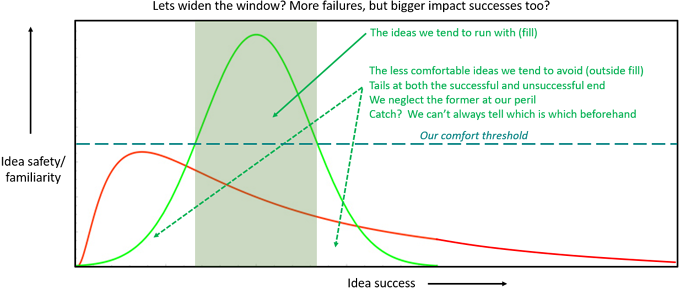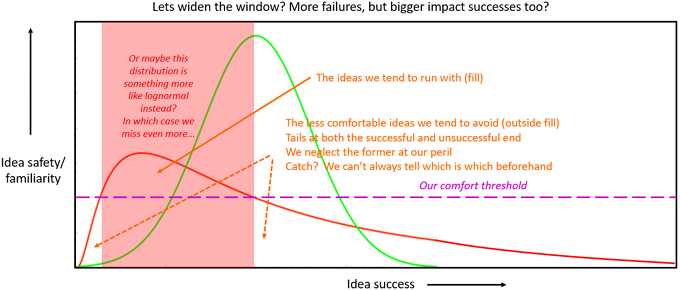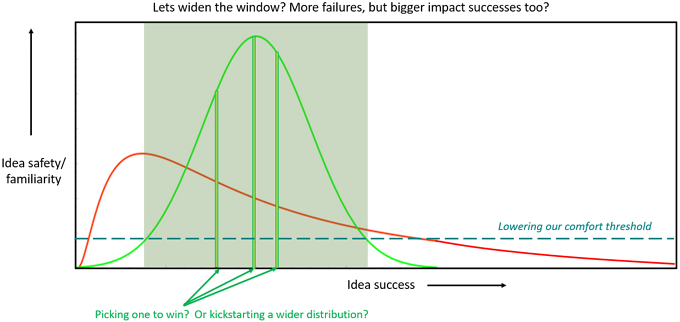
Dave Waters, Paetoro Consulting UK Ltd
Certainty and innovation are mutually exclusive
Innovation is a bit of a buzzword and there are lots of competitions out there trying to promote it. That’s a good thing, but I confess to thinking it’s not enough. The thing about competitions is there are only a few winners, who take the lot. That means putting eggs in one basket, a basket that may or may not succeed. A basket that always has risk attached. There is nothing inherently wrong with risk per se – reward goes hand in hand with it. But when engaging in risky ventures, there is safety in numbers. A portfolio. Do more of them so that if one fails it is not a total bust because you still have nine (or ninety nine) others on the go that might succeed.
There are ideas-funding initiatives out there that have been going for decades, that spread the funding more widely. They aren’t quite so glamourous maybe, and the winnings aren’t so big, but they give a leg-up to a much wider playing field. I’ve just been looking into the UK’s KTP (Knowledge Transfer Partnership) programme a bit, and it’s one of the better ones. Quietly working in the background for over four and a half decades, jointly funding initiatives between research and industry to transfer knowledge and develop ideas profitably.
The thing is, every idea that comes before these funding initiatives is peer reviewed, as it should be, and it matters who does that. It matters whether it is a conservative establishment – be it academic or a corporate board or a state body, or a combination of them working in unison. With genuine exceptions, such as ARPA in the US, these can sometimes be weighted to the risk-averse. Either sub-consciously or consciously. After all, very understandably, no-one wants to lose money. That pre-constrains the outcomes to those which these bodies feel safest with.
Difficult times, call for risk
To an extent that is fine, but in times of crisis, maybe there is a time for being bolder, funding more ideas that are less "safe", less certain, less "comfortable". It’s not necessarily an approach for always – but when there really are big problems to address that aren’t making much headway – it’s time to try something different. Funding more ideas that have greater chance of failure to ensure the “out-of-the-box” ones that can succeed do get through the filter. Maybe spending less on individual proposal funding, so that the cost of failure is less, but instead spreading the money across more proposals, giving more ideas a go.
That calls for increased boldness on the part of all bodies involved in funding. It perhaps means giving 100K to ten projects rather than 1 million to one. Or 20K to fifty projects. Without diluting the figure to a level that it is effectively useless. Then a stage-gate evaluation later on to see which ones have justified more spend in a next phase. There is more chance of picking a really big impact winner if we habitually go outside our comfort zone. This is a consideration for all the bodies engaged in funding research and development (R&D), whether it be public or private. Wherever R&D is funded.
A distribution dalliance
I’ve had a bit of a play with some distribution curves to illustrate the idea. Now I’m being a bit flippant here really – it is just illustrative. I’m not seriously suggesting something as insanely complex as human ideas generation can be fitted to a normal or lognormal distribution curve of relative "safety" versus success. Who knows what that distribution looks like!
Nevertheless it makes sense that whatever that distribution looks like in detail it has a hump in the middle bits and tails at the ends, and that the really “out-there” frontier-territory innovations that pierce new analytical terrain – will seem less comfortable and more risky to us. The ones that are doomed to failure, and the ones that are destined for surprising success, may look very similar at the early stages. If we knew what things would work in advance life would be very simple. We don’t. We initially perceive only the y-axis – how comfortable we are with an idea based on our experience, and not the x-axis of how successful it will be. We have a view on that of course, sometimes an intelligent one. But not prescience.
It's not about abandoning those standards. Just relaxing the belt a little bit more, to allow more venturing into that riskier but higher reward space.
This is an exercise in funding more of those to go a little bit further – not indefinitely – but just further enough along the evaluation route to see if they justify more effort. Many won’t, but some will.



Let’s not be too silly about it though
Now I’m not suggesting we plunge headlong into funding the outright daft. Proposals that want to subvert or ignore long established laws of physics or chemistry need to do so out of their own pocket thanks very much, or with some mad zillionaire in tow. Neither am I suggesting abandoning very tight stringency for long term nine-figure funding commitments.
Proposals that seek big new deployments of stuff across the board are in a different category. You don’t do that kind of thing or expect taxpayer/shareholder subsidy unless there is some real encouragement from project results. Maybe though, at the trying ideas out stage, when we are talking in increments of 50 thousand and not 50 million, there is room for giving a lot more a go. Rather than allowing our own preconceptions to cherry pick.
This is about the very initial stages of R&D, for those new ideas just off the drawing board. Giving more of them an initial foot in the door.
Being prepared to lose a little to gain a lot
If we always pick proposals based on stuff we totally understand and can guarantee a return on, we shouldn’t expect great new breakthroughs.
So, I’m not wanting to criticise all the great innovation competitions there are out there, just wanting to say more please, and maybe that a sustained "spreading the net wide" funding regimen is really what is needed. We overestimate our ability to pick real winners ahead of time, and we underestimate our own proclivity to stick with the safe stuff we understand, that is limited in what it can actually change. The answer, if we really want to take things into bold new innovations, addressing big questions, is to be bolder in what we fund at the initial R&D stages.
It’s not any fix-all solution, and bear in mind, it will inevitably imply more failures. More projects where the initial funding is sunk and lost. But it will allow more of those really game-changing high impact proposals to get a start – and the gain from those exceeds any loss for the former. A way of flying more kites to see which ones catch the wind best.
KeyFacts Energy Industry Directory: Paetoro Consulting
 KEYFACT Energy
KEYFACT Energy